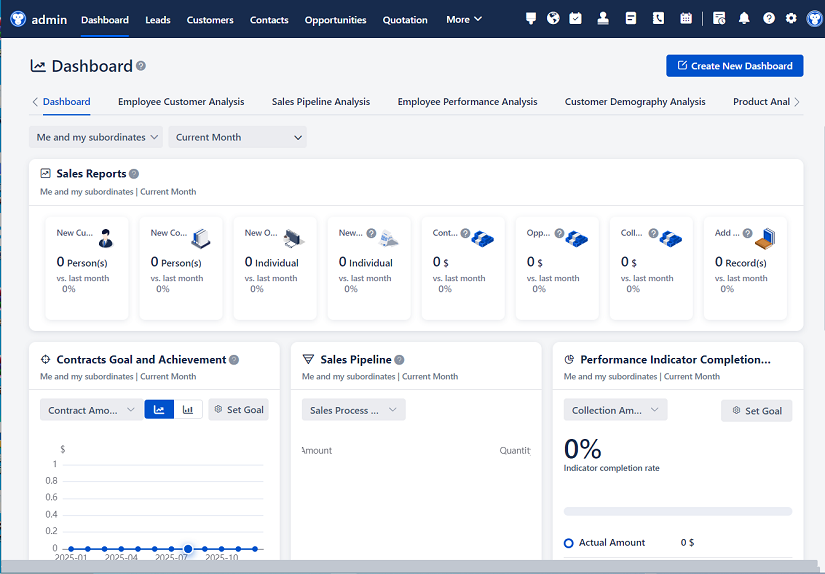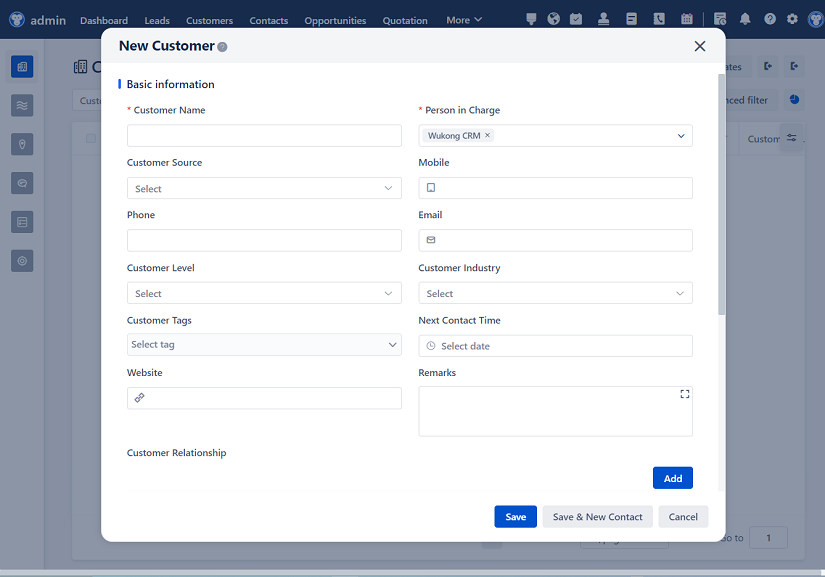
△Click on the top right corner to try Wukong CRM for free
So, let me tell you something I’ve been thinking about lately—customer relationship management, or CRM for short. You’ve probably heard of it, right? It’s that system businesses use to keep track of their customers, manage interactions, and, ideally, make people feel valued. But here’s the thing: not all CRMs are the same. I’ve been digging into this topic, and honestly, the differences between traditional CRM and something called sCRM—social CRM—are kind of fascinating. And more importantly, they actually matter when it comes to how companies connect with people today.
Let’s start with traditional CRM. You know, the kind that’s been around for decades. It’s mostly about collecting customer data—names, emails, purchase history, support tickets—and storing it in a centralized database. It’s super helpful for sales teams, customer service reps, and marketing departments. Think of it like a digital filing cabinet. You log a call, you record a sale, you tag a lead. It’s structured, organized, and pretty much inward-focused. The company controls the data, and the customer? Well, they’re kind of just… in the system.
Free use of CRM system: Free CRM
But here’s where things get interesting. Over the past 10 to 15 years, social media has exploded. People aren’t just buying products anymore—they’re sharing their experiences, good and bad, online. They’re tweeting, posting on Instagram, leaving reviews on Facebook, commenting on TikTok. And companies? They can’t just ignore that. That’s where sCRM comes in—social CRM. It’s not just about what the company knows about the customer, but what the customer is saying out in the open, on social platforms.
So, what’s the real difference between the two? Well, traditional CRM is transactional. It’s built around sales cycles and customer service tickets. It’s reactive. You call support, they log it, they fix it. End of story. But sCRM? It’s conversational. It’s about listening, engaging, and building relationships in real time. It pulls in data from Twitter, LinkedIn, Facebook, even review sites. It’s not just about what you bought, but what you said about it—and how your friends reacted.
And honestly, that changes everything. Imagine you’re a customer who just had a bad experience with a product. In the old CRM world, you might call customer service, wait on hold, explain your issue, and hope it gets resolved. But in the sCRM world? You tweet about it. You tag the company. Maybe you even post a video. And if that company is paying attention, they respond—publicly, quickly, and personally. That’s not just service; that’s engagement. That’s building trust in front of everyone.
Now, let’s talk about who uses what. Traditional CRM is still super relevant, especially in industries where relationships are more formal or transactions are complex. Think B2B sales, enterprise software, or financial services. These companies need deep data, long sales cycles, and detailed tracking. They’re not necessarily trying to go viral on TikTok. They want efficiency, accuracy, and predictability. So, traditional CRM fits like a glove.
But then you’ve got retail, fashion, food and beverage, entertainment—industries where brand image and customer sentiment matter a ton. These are the ones jumping on sCRM. Why? Because their customers are online, all the time, talking. And if you’re not part of that conversation, you’re invisible. I mean, think about it: when was the last time you bought something based on a friend’s Instagram story or a viral TikTok review? That’s sCRM territory.
Another big difference is data flow. Traditional CRM is mostly one-way: the company collects data from the customer. sCRM? It’s two-way, even multi-directional. You’re not just gathering data—you’re participating in conversations, responding to feedback, and even co-creating content with customers. Some brands even invite customers to help design products or suggest features. That kind of collaboration? That doesn’t happen in a traditional CRM system.
And let’s not forget about personalization. Both systems aim to personalize the customer experience, but they do it differently. Traditional CRM uses past behavior—what you bought, how often, what support you needed. It’s predictive, based on history. sCRM, on the other hand, uses real-time sentiment. It sees what you’re saying right now, how you’re feeling, what’s trending. So if you’re excited about a new product launch on Twitter, an sCRM-enabled brand can jump in and offer you early access or a discount. It’s not just relevant—it’s timely.

But here’s the catch: sCRM isn’t a replacement for traditional CRM. It’s more like an upgrade, or a companion. You still need the backbone of a solid CRM system to manage sales, track accounts, and handle service requests. But layering on sCRM gives you the social ear—the ability to listen at scale and respond in a human way.
I’ll give you a real-world example. A few months ago, I saw a coffee brand respond to a customer complaint on Instagram. The customer posted a photo of a damaged package, and within an hour, the brand replied, apologized, and sent a replacement—with a free bag of coffee as a bonus. That’s sCRM in action. But behind the scenes? They still used their traditional CRM to process the refund, update the customer’s account, and flag the shipping issue. So both systems were working together.
And that’s kind of the key point: integration. The most successful companies aren’t choosing between traditional CRM and sCRM—they’re combining them. They’re syncing social data into their CRM platforms, so sales reps can see a customer’s recent tweets before a call, or support agents can check if someone just complained online before they reach out. It’s about creating a 360-degree view of the customer—one that includes both transactional history and social behavior.
Now, let’s talk about challenges. sCRM sounds great, right? But it’s not easy. For one, the volume of social data is massive. Millions of posts, comments, mentions—how do you even keep up? That’s where AI and sentiment analysis come in. Tools can scan social media, detect sentiment (positive, negative, neutral), and flag urgent issues. But even then, it’s not perfect. Sarcasm, slang, cultural context—machines still struggle with that. So human oversight is crucial.

Another challenge is privacy. With sCRM, you’re pulling in public data, sure, but customers might not expect a company to monitor or respond to every tweet. There’s a fine line between being attentive and being creepy. I’ve seen brands go overboard—replying to every single mention, even the irrelevant ones. It feels robotic, not human. So you’ve got to be smart about it. Focus on meaningful interactions, not just volume.
And let’s be real: not every company is ready for sCRM. It requires a cultural shift. You can’t just buy software and call it a day. Your team has to be empowered to respond quickly, authentically, and sometimes even humorously. That means training, trust, and a willingness to let go of rigid scripts. In traditional CRM, everything is controlled. In sCRM, you’re dancing in public—and sometimes you’ll step on toes.
But when it works? Wow. I remember a time when a small skincare brand responded to my comment on a Facebook post. Not a complaint—just a question. And they didn’t just give a generic answer. They tagged their product developer, who explained the ingredient in detail. That made me feel heard. It made me trust them more. And guess what? I became a loyal customer. That’s the power of sCRM—it turns casual interactions into emotional connections.
So, to wrap this up: traditional CRM is about managing relationships from the inside out. sCRM is about engaging from the outside in. One is structured, the other is dynamic. One focuses on history, the other on the moment. And while they serve different purposes, the smartest companies use both. They keep the foundation of traditional CRM strong, but they add the social layer to stay relevant, responsive, and human.
In today’s world, customers don’t just want to be served—they want to be seen. They want to know that a brand is listening, not just selling. And whether you’re a small startup or a global corporation, ignoring the social conversation is no longer an option. So maybe it’s time to ask yourself: are we just managing customers, or are we really connecting with them?
FAQs (Frequently Asked Questions)
Q: Is sCRM only for big companies with huge social media followings?
A: Not at all. Even small businesses can benefit from sCRM. If your customers are talking about you online—whether it’s five people or fifty thousand—you should be listening. It’s about engagement, not scale.
Q: Do I need to replace my current CRM to adopt sCRM?
A: No, you don’t. Most modern CRM platforms actually support social integration. You can keep your existing system and add social monitoring tools on top. Think of it as an enhancement, not a replacement.
Q: Isn’t monitoring social media a huge time sink?
A: It can be, if you’re doing it manually. But there are tools—like Hootsuite, Sprinklr, or HubSpot’s social features—that automate a lot of the listening and alerting. You set keywords, and the system tells you when to respond.
Q: What if we respond to a customer online and make the situation worse?
A: That’s a valid concern. That’s why training matters. Your team should know the tone, boundaries, and escalation paths. And sometimes, the best response is to take the conversation private—like sending a direct message instead of replying publicly.
Q: Can sCRM really impact sales?
A: Absolutely. Studies show that customers who engage with brands on social media tend to spend more and stay loyal longer. Plus, resolving issues publicly builds trust with everyone watching—not just the person complaining.

Q: Is sCRM only about handling complaints?
A: Nope. It’s also about celebrating happy customers, sharing user-generated content, running social campaigns, and even spotting new product ideas from customer feedback. It’s not just damage control—it’s relationship building.
Q: How do we measure the success of sCRM?
A: Look at metrics like response time, sentiment trends, engagement rates, and even sales influenced by social interactions. But don’t forget the qualitative stuff—like improved brand perception or stronger customer loyalty.
Related links:
Free trial of CRM
Understand CRM software

△Click on the top right corner to try Wukong CRM for free